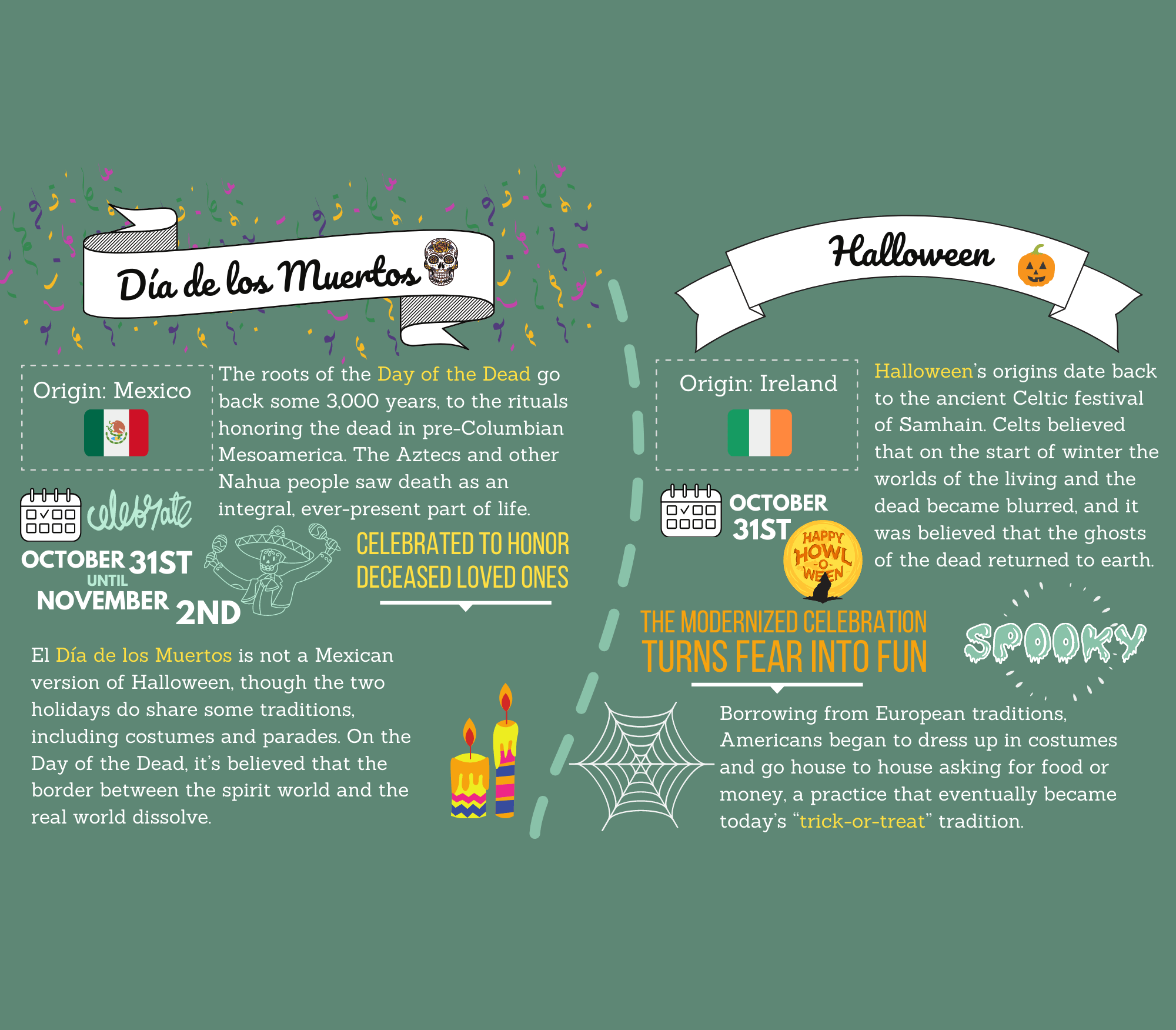Day of the Dead, or Día de los Muertos, is often mistaken for Halloween or someway, somehow, being tied into Halloween. However, contrary to popular belief, Mexico's famous Day of the Dead has very little to do with the Westernized holiday besides the overlapping date (October 31st).
At the surface of it all, both holidays have the cores aligned: a specific date, purpose, a reason to celebrate, notable symbols, and typical festivity food. Once we look deeply into it, though, we see that they each have their own differences. Feel free to view them below.
Día de los Muertos |
Halloween |
|
Celebrated throughout Latin America, but mostly celebrated in Mexico |
Mostly celebrated in Ireland, Canada and the United States |
|
As early as October 28th through November 2nd |
One day only -- October 31 |
|
Build an altar, make ofrendas and visit the cemetery |
Decorate the living space, parties, go door to door trick or treating, wear costumes and carve Jack o' Lanterns |
|
Colorful calacas and calaveras (skulls and skeletons), colorful traditional clothing, papel picado, Aztec marigold flower. |
Pumpkins, ghosts, spooky things (zombies, blood, horror). Skulls are associated to contribute to this fear, not celebration. |
|
Usually eat Pan de Muertos, candied pumpkins |
Pumpkin pie, popular candy from trick or treating |
|
Indigenous Aztec origins, now merged with Catholicism. |
Has pagan roots that now carries Christian All Saints' Day influence |
|
Banks and official buildings are usually closed during these days |
Everything remains open as it is usually celebrated at night |
Día de los Muertos festivities is mostly celebrated the night of November 1st to November 2nd. However, there are others who start lighting their candles and expecting their loved ones to "visit" from Mictán (the underworld in Aztec mythology) as early as the night of October 28th. This day is reserved for a visit from those who died by a tragic or unexpected death; the night of October 29th to those who died by drowning; the nights of October 30th and 31st is dedicated to the souls of the forgotten, who do not have family to remember/pray for them; November 1st is dedicated to all children who passed away too early; and, lastly, on November 2nd, we commemorate and expect all of our loved ones to visit and become part of the community for one night. There are different ways to celebrate November 2nd, which is a holiday in Mexico and some parts of Latin America, but the most traditional one includes spending the night (and sometimes day) at the cemetery with live music like mariachi, food, and beverages, or at least paying a visit out of respect.
There are some misconceptions with these party-like celebrations that claim that Mexicans and other cultures who "celebrate" death do so for lack of respect. However, this celebration is rooted in respect. The same as others, for Mesoamerican cultures, death was important and something to be respected. For this reason, it was believed that showing mourning and respect would anger those that have passed away as well as the god from the underworld (Mictlantecuhtli). From here emerges Mexicans' approach to death where we celebrate it in order not to anger it and so, when we reach it, it is happy with us. Nobel Awardee, Octavio Paz in his famous book The Labyrinth of Solitude (1950) writes:
"Para el habitante de Nueva York, París o Londres, la muerte es la palabra que jamás se pronuncia porque quema los labios. El mexicano, en cambio, la frecuenta, la burla, la acaricia, duerme con ella, la festeja, es uno de sus juguetes favoritos y su amor más permanente. Cierto, en su actitud hay quizá tanto miedo como en la de los otros; mas al menos no se esconde ni la esconde; la contempla cara a cara con impaciencia, desdén o ironía: "si me han de matar mañana, que me maten de una vez".
"To the people of New York, Paris, or London, 'death' is a word that is never pronounced because it burns the lips. The Mexican, however, frequents it, jokes about it, caresses it, sleeps with it, celebrates it; it is one of his favorite toys and most steadfast love. True, there is as much fear in his attitude as in that of others, but at least death is not hidden away: he looks at it face to face, with impatience, disdain or irony: 'if they must kill me, let them kill me once and for all'"
With all of this being said, Day of the Dead has started to take off in the Americas and meshing with Halloween, with more and more Mexican Americans choosing to participate in both celebrations. Recently, the popular Disney movie Coco, has created more awareness and pushed more people to practice it, as it perfectly showcases how Día de los Muertos is celebrated as well as some traditions and attributions to an audience that often celebrates Halloween.
Shop some Día de los Muertos gear below


Dia de los Muertos Puebla Mask


Papel Picado (Calacas Doing Things Banner)
Medium Paper Mache Hand Painted Sugar Skulls









1 comment
Eileen Swinehart
I love that you give such a detailed explanation of this wonderful tradition. And I love your products! They are fantastic.